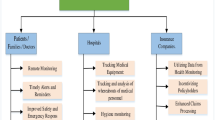Abstract
In our aging society, mHealthcare social network (MHSN) built upon wireless body sensor network (WBSN) and mobile communications provides a promising platform for the seniors who have the same symptom to exchange their experiences, give mutual support and inspiration to each other, and help forwarding their health information wirelessly to a related eHealth center. However, there exist many challenging security issues in MHSN such as how to securely identify a senior who has the same symptom, how to prevent others who don’t have the symptom from knowing someone’s symptom? In this paper, to tackle these challenging security issues, we propose a secure same-symptom-based handshake (SSH) scheme. Specifically, in the proposed SSH scheme, each patient is granted with a pseudo-ID and its private key corresponding to his symptom. When two patients meet, only if they have the same symptom, they can use their private keys to make mutual authentication. With the provable security technique, we demonstrate the proposed SSH is secure in the MHSN scenarios. Moreover, we also discuss a promising application – social-based patient health information (PHI) collaborative reporting in MHSN, and conduct extensive simulations to evaluate its efficiency in terms of PHI delivery ratio and reporting delay.






Similar content being viewed by others
Notes
Note that if the patent user U i have more than one kind of symptoms, he can obtain all corresponding private keys. In our current work, we consider each patient only has one kind of symptom.
References
Lu R, Lin X, Liang X, Shen X (2010) Secure handshake with symptoms-matching: the essential to the success of mhealthcare social network. In: Proc. BodyNets 2010, Corfu Island, Greece
Appari A, Johnson ME, Anthony DL (2009) HIPAA compliance in home health: a neo-institutional theoretic perspective. In: SPIMACS ’09, pp 13–20
Chen M, Gonzalez S, Zhang Q, Li M, Leung V (2010) A 2g-rfid based e-healthcare system. IEEE Wirel Commun Mag 17(1):37–43
Wang H, Peng D, Wang W, Sharif H, Chen HH, Khoynezhad A (2010) Resource-aware secure ECG healthcare monitoring through body sensor networks. IEEE Wirel Commun Mag 17(1):12–19
Li M, Lou W, Ren K (2010) Data security and privacy in wireless body area networks. IEEE Wirel Commun Mag 17(1):51–58
Sun J, Fang Y, Zhu X (2010) Privacy and emergency response in e-healthcare leveraging wireless body sensor networks. IEEE Wirel Commun Mag 17(1):66–73
Cheng H, Zhuang W (2010) Bluetooth-enabled in-home patient monitoring system: early detection of Alzheimer’s disease. IEEE Wirel Commun Mag 17(1):74–79
Misic J, Misic V (2010) Bridge performance in a multitier wireless network for healthcare monitoring. IEEE Wirel Commun Mag 17(1):90–95
Chen M, Gonzalez S, Vasilakos A, Cao H, Leung V (2010) Body area networks: a survey. ACM/Springer Mob Netw Appl (MONET) 17(1):37–43. doi:10.1007/s11036-010-0260-8
Kotz D, Avancha S, Baxi A (2009) A privacy framework for mobile health and home-care systems. In: SPIMACS ’09, Chicago, Illinois, USA, pp 1–12
Liang X, Lu R, Lin X, Shen X (2010) Patient self-controllable access policy on PHI in ehealthcare systems. In: AHIC 2010, Kitchener, Ontario, Canada
Lin X, Lu R, Shen X, Nemoto Y, Kato N (2009) SAGE: a strong privacy-preserving scheme against global eavesdropping for ehealth systems. IEEE J Sel Areas Commun 27:365–378
Boneh D, Franklin M (2003) Identity-based encryption from the weil pairing. SIAM J Comput 32(3):586–615
Shoup V (2002) OAEP reconsidered. J Cryptol 15(4):223–249
Izabachene M, Pointcheval D (2008) New anonymity notions for identity-based encryption. In: SCN ’08. LNCS 5229, pp 375–391
Bellare M, Rogaway P (1993) Random oracles are practical: a paradigm for designing efficient protocols. In: CCS ’93, pp 62–73
Pietilainen AK, Diot C (2009) Social pocket switched networks. In: INFOCOM’09, Rio de Janeiro, Brazil, pp 403–404
Balfanz D, Durfee G, Shankar N, Smetters D, Staddon J, Wong H (2003) Secret handshake from pairing-based key agreements. In: IEEE S&P ’03, pp 180–196
Su R (2009) On the security of a novel and efficient unlinkable secret handshakes scheme. IEEE Commun Lett 13(9):712–713
Zhou L, Susilo W, Mu Y (2006) Three-move secret handshakes. In: ISPEC 2006. LNCS 3903, pp 332–342
Lu R, Lin X, Zhu H, Shen X, Preiss BR (2010) Pi: A practical incentive protocol for delay tolerant networks. IEEE Trans Wirel Commun 9(4):1483–1493
Author information
Authors and Affiliations
Corresponding author
Additional information
Part of this paper was presented at the 5th International Conference on Body Area Networks (BodyNets’10) [1]. This work was supported in part by the Natural Sciences and Engineering Research Council of Canada.
Rights and permissions
About this article
Cite this article
Lu, R., Lin, X., Liang, X. et al. A Secure Handshake Scheme with Symptoms-Matching for mHealthcare Social Network. Mobile Netw Appl 16, 683–694 (2011). https://doi.org/10.1007/s11036-010-0274-2
Published:
Issue Date:
DOI: https://doi.org/10.1007/s11036-010-0274-2




